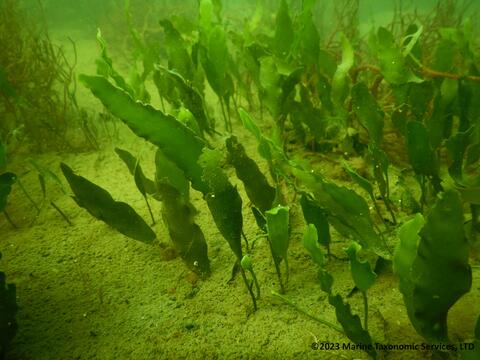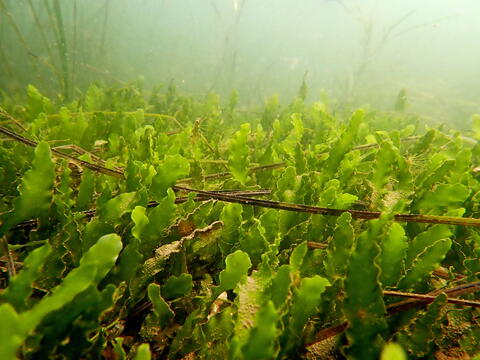Port of San Diego Renews Emergency Declaration to Eradicate Invasive Seaweed in South San Diego Bay
Contact: Brianne Page, 619.348.1518, bpage@portofsandiego.org
More Caulerpa Patches Discovered
The Port of San Diego is continuing its local emergency declaration in the fight against the spread of an invasive algae scientifically known as Caulerpa prolifera in San Diego Bay. Since its discovery in September 2023, additional Caulerpa patches have been found within and adjacent to the Coronado Cays.
Caulerpa prolifera is a type of tropical algae that grows and reproduces extremely quickly, choking out native seaweeds and seagrasses, potentially harming marine life through loss of habitat. In San Diego Bay, the primary concerns are to protect eelgrass and the fish, birds and green sea turtles that rely on eelgrass for food and shelter. San Diego Bay has nearly 2,600 acres of eelgrass, 1,900 of which are in the south bay. In addition to providing critical shelter and food for the bay’s wildlife, eelgrass is also a natural water filter and sequesters carbon, which are important for good water and air quality.
“It is absolutely critical that we find and remove or cover every little piece of Caulerpa as quickly as possible to preserve our bay’s strong and healthy ecosystem,” said Chairman Frank Urtasun, Port of San Diego Board of Port Commissioners. “Caulerpa is also a potential threat to local jobs and businesses. In the 1980s, a Caulerpa outbreak in the Mediterranean Sea caused millions of dollars in losses to tourism and fishing industries because it was not contained. We will not let that happen in San Diego Bay. With our many local, state, and federal partners, we are being swift and prudent to protect both our environment and our economic interests.”
In late September, divers found a small patch of Caulerpa prolifera in the Coronado Cays while conducting an in-water pre-construction eelgrass/Caulerpa dive survey as a permit condition for a dock replacement project. In follow-up dive surveys, additional patches were found in the Cays. Then, in mid-April, divers found small Caulerpa patches in the San Diego Bay National Wildlife Refuge outside of and adjacent to the Cays. To date, nearly 11,200 square feet of the seaweed have been discovered. Trained divers have covered all the patches with a sealed barrier to kill the algae by blocking it from light, oxygen, and tidal circulation.
The most likely source of this infestation is the release from a saltwater aquarium into the bay as Caulerpa is a popular and common saltwater aquarium plant. Because of the environmental risks, it is illegal in California to possess, sell, or transport any Caulerpa seaweed (AB 655, 2023). Fines can range from $500 to $10,000 for each violation.
If you have or sell saltwater aquariums:
- DO NOT use Caulerpa in your aquarium.
- DO NOT dump your aquariums into California waters or even pour the contents into streets or down storm drains that often discharge to the bay or ocean. ONLY drain aquariums into sinks or toilets as the water will circulate to a treatment plant that would help minimize the threat.
- DO NOT share or sell Caulerpa.
Caulerpa can rapidly and aggressively expand from contact with vessels, fishing, and even tidal exchanges. To prevent unintentional spread of this invasive species, boaters, kayakers, swimmers, and divers are asked to avoid the infested areas, if possible, or to gently transit at high tide. Caulerpa is not harmful to humans who come into contact with it.
If you are a boater, diver, or angler:
- Learn what Caulerpa looks like and keep an eye out for it.
- Inspect your anchor, fishing gear, or nets for Caulerpa that may have been picked up from the bottom.
- Learn more and report sightings to the California Department of Fish and Wildlife at wildlife.ca.gov/Conservation/Invasives/Species/Caulerpa.
To date, just over $900,000 has been committed to cover the costs of diver surveys and eradication, including $92,000 contributed by the Port and $350,000 in Bipartisan Infrastructure Law funding secured by the Port and the U.S. Fish and Wildlife Service. An additional $2.2 million in funding is pending from federal and state sources, along with up to $500,000 included in the Port’s preliminary FY 2025 Budget. The Port’s continued emergency declaration will be helpful in securing additional grant funding as the Port and its partners continue surveillance, control measures, and monitoring.
This is the first discovery of Caulerpa prolifera in San Diego Bay. An infestation in Newport Bay has been battled since 2021. Another species of Caulerpa infested part of Huntington Harbour and Aqua Hedionda Lagoon in Carlsbad in the early 2000s. In California, there has been routine monitoring of Caulerpa since the early 2000s.
Since the initial discovery, the Port has been working diligently with the Southern California Caulerpa Action Team (SCCAT) consisting of state and federal resource agencies to develop and implement an immediate response plan to prevent the spread and further infestation of this algae.
The SCCAT has prepared a Rapid Response Eradication Plan to address the immediate need to eradicate this invasive species. This plan includes the following components:
- Control of Infestation Site – To prevent disturbance by boat anchors and boat wakes, the affected areas are being controlled through coordination with the Coronado Cays Homeowners Association and slip occupants.
- Localized Eradication Level Survey – Diver surveys are being conducted within and adjacent to the affected area. Divers locate, record, and map any Caulerpa prolifera found.
- Treatment – The Caulerpa prolifera is being covered by trained divers with a sealed barrier that will kill the algae by blocking it from light, oxygen, and circulation. This method has been successfully used in the past at other Caulerpa infestation sites in other areas of Southern California.
- Post Treatment Surveys – Diver surveys will be conducted both immediately following treatment and over a longer timeframe to help ensure the species is completely eradicated and does not repopulate the area.
- Broad Area Surveys – Diver surveys will occur in surrounding areas of San Diego Bay to determine if other areas have been invaded.
The SCCAT includes representatives from federal and state resource agencies including the Army Corps of Engineers, the California Coastal Commission, California Department of Fish and Wildlife, National Marine Fisheries Service, Santa Ana and San Diego Regional Water Quality Control Boards, State Lands Commission, U.S. Fish and Wildlife Service, and U.S. Navy.
About THE Port of San Diego
The Port of San Diego serves the people of California as a specially created district, balancing multiple uses on 34 miles along San Diego Bay spanning five cities. Collecting no tax dollars, the Port manages a diverse portfolio to generate revenues that support vital public services and amenities.
The Port champions Maritime, Waterfront Development, Public Safety, Experiences and Environment, all focused on enriching the relationship people and businesses have with our dynamic waterfront. From cargo and cruise terminals to hotels and restaurants, from marinas to museums, from 23 public parks to countless events, the Port contributes to the region’s prosperity and remarkable way of life on a daily basis.
ABOUT PORT OF SAN DIEGO ENVIRONMENT
Port of San Diego Environment champions the safekeeping and environmental care of our diverse ecosystems. Year after year, environmental goals are set and measured to evolve environmental initiatives – ensuring San Diego Bay remains a vibrant resource and contributes to a remarkable way of life for visitors and residents for generations to come.

